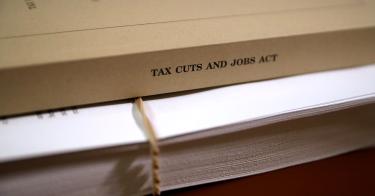President Biden is preparing a massive tax-and-spend plan that would greatly expand the federal government and harm economic growth.
The higher taxes being put forth by Mr. Biden would reverse important aspects of the Tax Cuts and Jobs Act signed into law by then-President Trump in 2017. Those tax increases would also reverse the substantial economic gains that resulted from the tax cuts and the improved regulatory climate ushered in under Mr. Trump.
In making the case for tax increases, Mr. Biden and others have relied on several myths about the 2017 tax cuts.
Myth: The cuts were just for the rich
An often repeated, but untrue, claim is that the tax cuts were just for the highest income Americans.
>>> An Economic History of the Tax Cuts and Jobs Act: Higher Wages, More Jobs, New Investment
More than 80% of taxpayers saw a lower tax burden, and IRS data confirm that every income group benefited from lower effective tax rates the year after the law was enacted.
In fact, the law made the tax code even more progressive. Taxes paid by the bottom 50% of earners fell by more than 10% after the tax cuts, compared to just a 0.04% drop for the top 1%. In 2018, the top 1% of earners paid 40% of the income taxes—up from 38% before the tax cuts.
Myth: The cut for corporations didn’t help workers
In 2017, U.S.-based companies faced the highest corporate income tax rate in the industrialized world, putting them at a serious competitive disadvantage. The tax cuts reduced that rate from 35% to 21%, reduced double taxation, encouraged business investment, and supported job and wage growth for workers.
In the two years after the tax cuts, wages increased by more than $1,400 above the previous trend for production and nonsupervisory workers. In 2019, real household income reached an all-time high.
The unemployment rate fell to a 50-year low as new job openings surged, and tens of thousands more people were able to voluntarily leave old jobs for better opportunities.
Business investment boomed even beyond what government economists had projected, although these gains were later undermined by tariffs and trade uncertainty.
While the tax cuts worked as intended and had positive results, the corporate tax rate is still too high to give U.S. workers the best possible environment to succeed in the global economy. In 2020, 25 OECD countries still had a lower corporate tax rate than the U.S.
If Mr. Biden raises the corporate tax rate to 28%, it would put the United States back in the dubious position of again having the highest tax rate on businesses among our international competitors.
Myth: The cuts caused the high deficits
Mr. Trump and other Republicans sometimes misleadingly asserted that the tax cuts would pay for themselves. These claims unfortunately confused the public about the true purpose of tax reform, which was to allow more Americans to keep more of the money they earn and strengthen the economy, not to maximize the revenues for the federal government.
>>> Solutions: Debt and Annual Spending
It is also a complete fabrication to blame the tax cuts for the Treasury’s poor fiscal health, which is due to the unsustainable growth in government spending for several decades and exacerbated by more spending increases following the tax cuts.
The recent $1.9 trillion stimulus bill will add more in debt by next year than the Tax Cuts and Jobs Act was projected to reduce revenue by over a decade. Biden’s new $3 trillion spending proposal is twice the size of the tax cuts.
Reversing the tax cuts would be a big mistake and would hinder the much-needed economic recovery process. Instead of higher spending and damaging tax hikes, Congress and Mr. Biden should prevent tax increases, continue making the tax code more competitive, and get spending under control.
This piece originally appeared in The Washington Times



